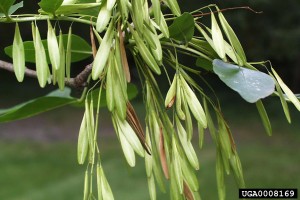Until recently I don’t think I could have identified an Ash tree to you, to me this species of tree was just one of the many that you see throughout Toronto. Then I came across some information about a certain little pest that is wreaking havoc on these poor, unfortunate trees. That pest is the Emerald Ash Borer. In particular the information that got my attention is the estimation that the City of Toronto will lose nearly all of its 860,000 ash trees to this maniacal pest by the year 2017. A staggering number and one that represents over 8% of our total canopy cover.
What is the Emerald Ash Borer? The EAB is an insect pest introduced from Asia that attacks and kills ash trees. The insects cut off the flow of water and nutrients within the trees by feeding underneath the bark. All species and sizes of ash trees (genus: Fraxinus) are susceptible. If a tree has become infested with EAB, mortality will generally result within 2-3 years. In North America, the beetle was initially discovered in Michigan and southwest Ontario in 2002, and the first infestations in the City of Toronto were detected in 2007.
How can you protect your trees? Well the first obvious step is to determine whether or not you have a True Ash tree (not a Mountain Ash as they are not True Ash trees) on your property. A True Ash is a medium to large tree with compound leaves, typically having 7 to 9 leaflets and paddle shaped seeds.

Ash branches are characterized by oppositely arranged
buds and leaves on the twigs. Twigs tend to be stout, able
to hold large compound leaves.
For more information on how to identify True Ash Trees it’s always a good idea to consult a certified arborist and here are a few good sites that give some extra insight:
http://www.yourleaf.org/ash-eab-identification
http://www.london.ca/Trees_Lawns_and_Gardens/PDFs/EAB_identificationguide.pdf
http://www.nyis.info/?action=eab_woodlot_ash
You’ve identified your tree as a True Ash, what should you do next? At this point you need to figure out if your tree is infested or not. The best possible way to do this is to consult a certified arborist. The International Society of Arboriculture has a listing of certified arborists in your area, so check out www.isa-arbor.com or call 1-888-463-2316 to get more information. It is often difficult to detect the presence of EAB in the early stages, as many of the visible signs and symptoms appear only after two or more years of infestation. However, the following signs may be visible:
- S-shaped larval gallery
- D-shaped beetle exit hole
- Feeding notch in the leaf
If your tree is being attacked it may show the following symptoms:
- Premature yellowing of foliage
- Dead branches
- Thinning crowns
- Bark cracks
- Shoots (suckers) growing our of the trunk
- Heavy seed production
- Woodpecker and squirrel feeding sites
It’s important to realize that other insects, diseases and problems can lead to these symptoms, that’s why you should consult with a certified arborist!
Your Ash is healthy, what should you do? There is a product called TreeAzin that is registered for use in Canada as a treatment against EAB. It is produced from extracts of Neem tree seed. You may want to consider TreeAzin injections if your Ash tree appears healthy. You should also know that you can also choose to treat city-owned trees on the road allowance in front of your home. Treatment is regulated by a service agreement and will be at your expense; may not sound like a great deal but consider the length of time it takes to grow a tree and the potential impact the lack of a tree may have on your property. If you’re interested in going this route you can hire contractors that are bound by an agreement by clicking here.
If you find out that your tree is indeed infested you will certainly need to consult with a qualified tree care company to help you deal with the next steps. You should also be aware that the City of Toronto’s Urban Forestry department plans to remove dead and dying city-owned front yard ash trees and will replace them, where space permits, as soon as possible.
If you are in the position of having to replace your Ash tree, LEAF (which stands for Local Enhancement & Appreciation of Forests an organization that has supplied most of the information found in this post and is a fantastic resource for the residents of Toronto) offers a subsidized Backyard Tree Planting Program. They provide arborist advice to help select the right EAB resistant tree for your yard and offer hardy native trees and planting services all at a subsidized price, for more information click here. The City of Toronto also offers a free Street Tree Planting Program for more information click here.

